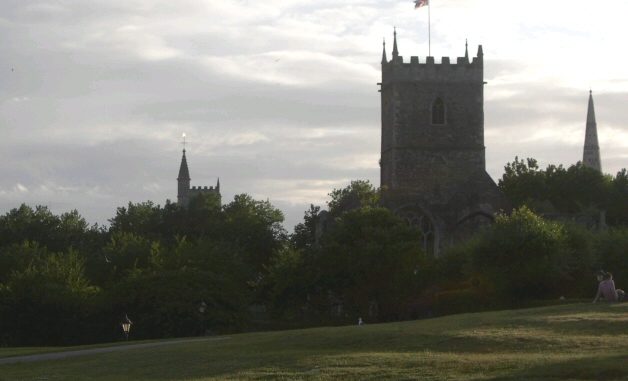
Bristol calls itself Britain’s First Bicycling City; it could very well call itself Britain’s First City of Hanging Plants. If you’re unfamiliar with Bristol, it is one of Britain’s major cities; the largest one in the southwestern corner of the country. It lies just north of Bath — the other major British city in the southwest corner of the country — in fact the two are generally thrown together in conversation — when I told Bill Badger (an English friend) I was going to Bristol, he told me I’d enjoy myself in Bristol and nervy Bath. The ‘nervy’ was a typo — he meant ‘nearby’. I didn’t have a car, so Bath wasn’t actually nearby if I had to walk — although I later found out I could have taken a bus. With three days to spend in Bristol on a work trip — two of them work days — Bath was out of the question. I concentrated on Bristol.
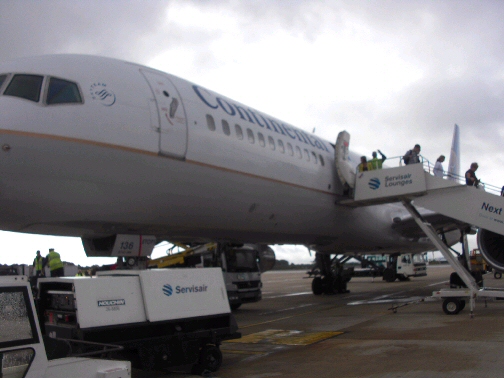
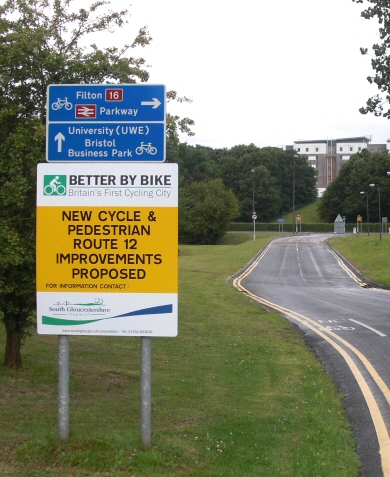
Took the Continental redeye from Newark Airport to Bristol on a Saturday night, which got me into Bristol Airport at 830 am on a Sunday morning. What a wonderful flight Continental is running — a 757 with better spacing between seats than I’ve experienced on all airlines in the recent past (you can actually open and use your laptop in front of you again), an ac outlet on the floor beneath the seats and a pretty expansive selection of movies and music in the at-seat personal entertainment system. The direct flight meant I wasn’t running around German airports trying to go from one end of the massive airport to another to catch a connecting flight — going thru security at least once if not twice (Hamburg) and always missing the connection (impossible to actually make) and then waiting in the airport for five hours for the next flight after the people at the gate look at you incredulously at how you could have missed your flight.
I stayed in a Holiday Inn in the town of Filton, in the suburbs north of Bristol — a 20 minute bus ride from the center of town. Two pounds 80 pence gets you from Town Center to Filton; much cheaper than the 25 pound taxi fare. Then there’s a bus from Town Center to the Airport that takes 45 minutes and cost 9 pounds round trip. Once in Bristol you can walk the city.
An all-day bus fare costs just under 4 pounds and gets you to the outer edges of the city; places like Cheltenham Road in Kingsdown where — I learned later on — you might want to go for music clubs, cafe’s, andgraffitti.
So that’s what I did on my first Sunday there — took a bus from the airport to Town Center, then took a cab to the hotel for 25 pounds because I didn’t know what I was doing; slept 4 hours in the hotel until late afternoon, and then jumped on a bus back into town to explore Bristol.
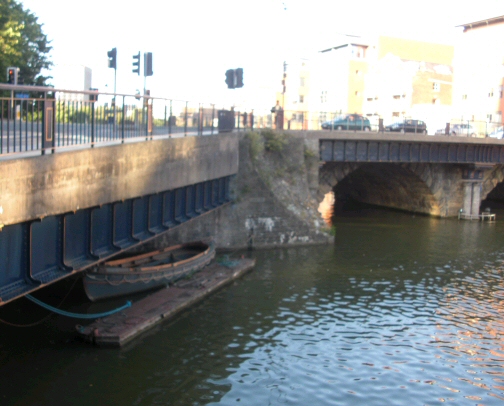
The famous Avon River cuts through, and runs out to Bristol Channel and the Atlantic Ocean. This has historically made Bristol an important port town. John Cabot set forth from Bristol. On his most famous journey, Cabot set forth from Bristol in 1497 on the ship called Matthew and discovered Newfoundland and Nova Scotia (although he thought they were China). There’s supposedly a reproduction of the Matthew located in Bristol harbor, but I didn’t see it, although I didn’t have time to venture deep down into the harbor. And Bristol was the capital of the slave trade in the 1700’s — slave ships were built in Bristol. Manufactured goods were sent down to Africa where they were traded for slaves, who were brought back to Bristol and loaded onto slave ships bound for the New World, mostly the Southern US where they were exchanged for tobacco and cotton. I learned this on one of the historical placards by the Avon River in Bristol.
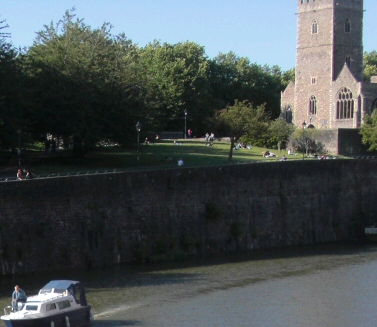
The Germans bombed the shit out of Bristol at the beginning of World War II. The Brits have left a couple of churches that were bombed by the Luftwaffe as they were, as a memorial and reminder of the thousands that died. And so that’s one of the first places that drew me in, in Bristol — St. Peter’s Church at the top of Castle Park. I got off the bus (a few stops errantly past my intended destination of town center), saw the ancient church in the park with all the people sitting on the grass and headed right for it. Lots of love going on in the park; young couples cozying up everywhere. Bristol is a college town, and the center of town and Castle Park are a five minute walk from College Square of the University of Bristol.
This being England, there actually used to be a castle in Castle Park; remnants of its castle walls are left and preserved (and you can touch them and climb on them) in various parts of the park, with placards detailing their history.
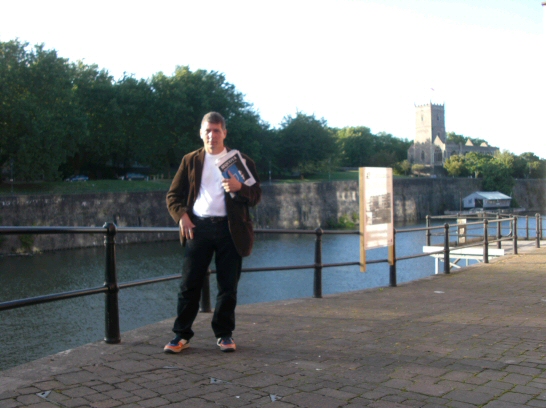
And there are seagulls everywhere, flying about. Bristol is a port town remember. Seagulls squawk. I’m very familiar with seagulls as a resident of Staten Island and frequent visitor of its beaches, and daily rider of the Staten Island ferry. So I know seagulls squawk but the seagulls in Bristol have a different accent than the ones in NY Harbor. They have a deeper, longer call and seem to mock you constantly as they fly about. I can imagine them mocking John Cabot as he set sail in 1497. They’re a salty bird — the Bristol seagulls — they’ve seen it all. So as I was looking down into one of the tunnels of the castle — its Sally Port (see pictures to left), closed off by a simple gate door, a local Englishman walking past with two gal pals started squawking at me from 30 yards as they passed, expertly mimicking a Bristol seagull. And then in a haunting halloween voice he warned me not to go down into the tunnel; it was a scary, scary place. Typical playful Brit.
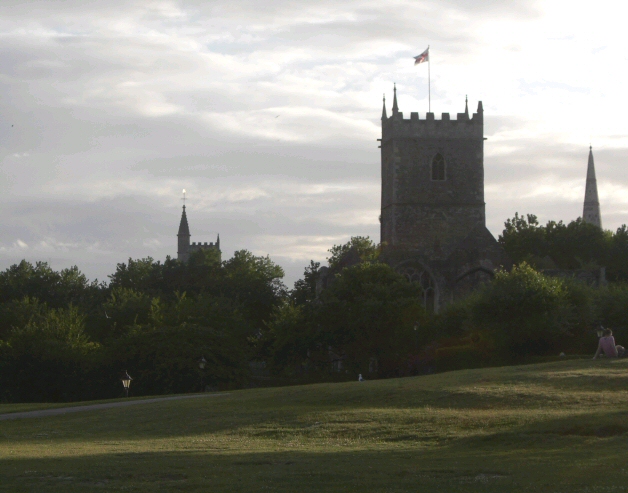
At the center of town there is something called the Christmas Steps. This is the name of the part of town, like Soho or Greenwich Village are to New York City. There are signs about town giving you directional arrows to various areas, and you’ll frequently see “Christmas Steps” with an arrow pointing that-a-way. I stumbled upon the Christmas Steps, and indeed it is a long narrow, fairly steep stairway that starts in a nondescript alleyway near center of town, and goes up for two blocks. As I walked up them, I could only imagine how pretty they were decorated during Christmas time and why they came to be known as the Christmas Steps.
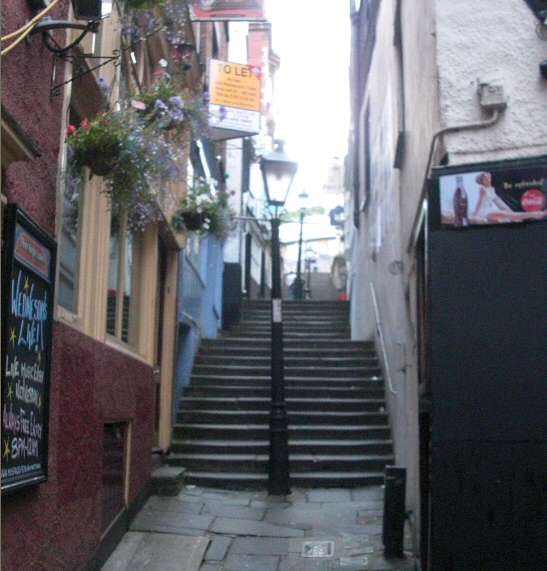
There is crime in Bristol — hooligans are here and there. Young white kids that look like they don’t have a job. So you’ve got to have eyes behind your head, especially when bouncing around alleys like by the Christmas Steps. Just at the base of the Christmas Steps there is a fast food takeout that provides traditional fish and chips. I’ve been to the UK over a dozen times in my life and to this date had only been able to find ‘touristy’ fish and chips. But I stumbled past this non-descript shop and I wasn’t even hungry, but the food looked and smelled so good, I had to try it. Two people before me got the last of the fish – and there is a choice of fish — cod for one, but other fish types too; I’ve forgotten the selection. And there was sausages and chips, something called a pasty and chips, and so forth. “No more fish?” I asked the proprietor, a dark haired, proud, hard-working Moroccon looking fellow of about 35. “Sure there is I’ll make some fresh for you”, he replied. I said I’d have the cod. He told me 10 minutes, so I waited.
Two hooligans entered the store, one with a cast on his foot, the other, his buddy, walking a large St. Bernard. They were 20 something, skinny as bean polls; looked like they hadn’t eaten all day. “You can get a sausage” said the dogwalker to his buddy. The two dug through their pockets for enough change as the proprietor eyed them up and down suspiciously. “No dogs in here”, he told them, but they didn’t give him any mind. He continued to prepare their sausage. “No dogs in here”, he told them again, more adamant this time, and a compadre came up from the kitchen to confront the hooligans. The dogwalker pulled his dog outside, looked to post him somewhere for a second; then brought him back in, gave his friend money for the sausage, which was plunked down and the sausage and change returned. The dog walker brusked past me to pour some vinegar and salt on the sausage, gave it to his friend and they walked out in a huff. He threw the napkin on the floor in front of the shop and they walked off. The kinds of guys who would give you trouble; I wondered how the one broke his foot.
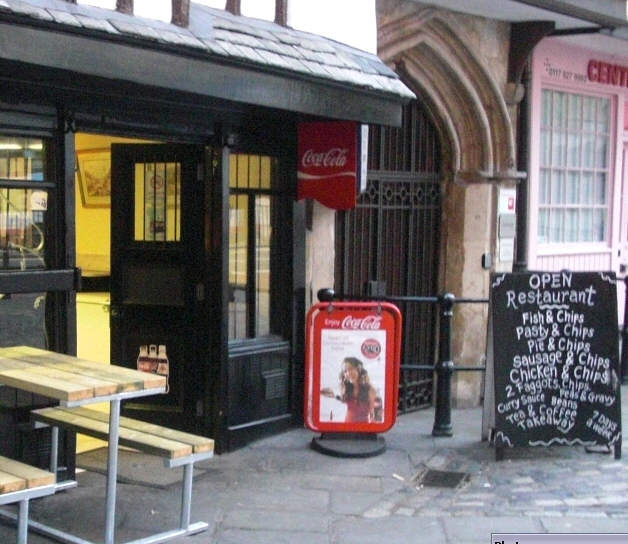
The proprietor had pictures of Fidel Castro in his shop. And Che Guevara. No doubt a fan, I started to wonder if he was Moroccon or Cuban. He seemed Moroccon. When the fish was ready, he put it on a large white paper (about the size of a standard newspaper, but white), laid a bed of french fries (each about the size of your thumb) next to it, sprinkled the fries with salt and poured a thin stream of vinegar on them (after asking me if I wanted salt and vinegar to which I said yes), and wrapped them up neatly together, and handed it to me. I thanked him and put it under my arm (under the papers I was carrying) as if it was a parcel. I wasn’t hungry but figured I’d eat it when I got back to the hotel. It smelled so good, however, I started nibbling on it at the bus stop. And it tasted so good — the cod so fresh and the chips so tasty, even seemingly healthy tasting — not as much grease as you get on McDonald’s or Nathan’s fries — that I finished it all off on the bus back to the hotel.
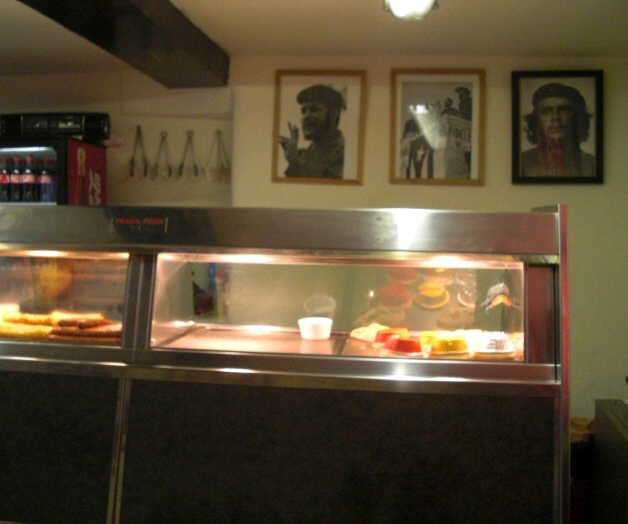
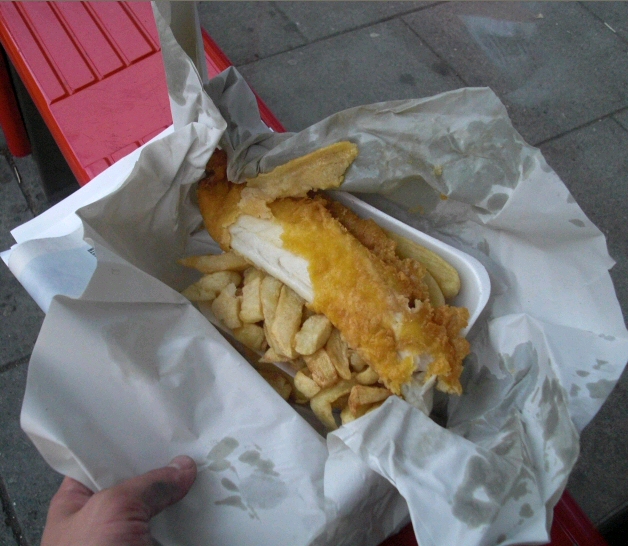

The bus runs to and from Filton until midnight, then starts again at 7am. The next day was a work day. Abbey Woods is located in Filton — it is the main headquarters of the UK Ministry of Defence (MOD). Nothing to do with Abbey Road. It is a complex of the most modern looking buildings. I’m told it was the opposite of that 15 years ago but there was a major renovation. It is quite impressive now. Also the Concorde jet was developed in Filton, and there is a nearby museum which lets you climb aboard one. I wasn’t able to get there this trip, but did hit the pool in the hotel on day 2. After work on day 3 (a Tuesday), I again ventured back into Bristol. This time I mucked about the northwestern section of the town, on the long hill that runs from Town Center up past the Bristol University.
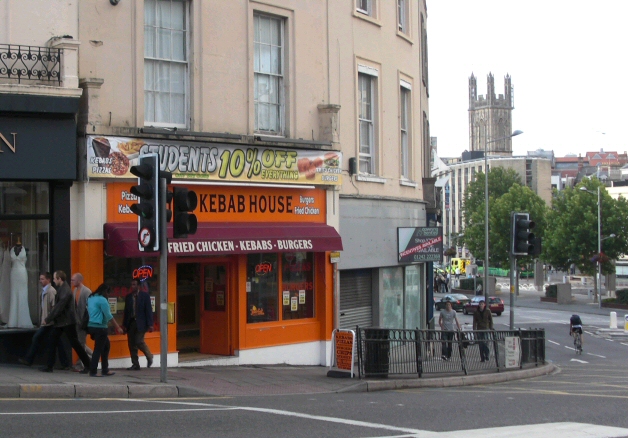
Almost every store closes at 5:30 pm on a Tuesday in that section of town, and I was there at 7 pm. So I missed going into the musical instruments shop, the bookstore, the music shop, and all the cafes. Only the pubs were open by that time, even though it was a college area — however a college area in mid July when all but summer classes are out, no doubt caused much of the early closings. I was on a curfew on this night as I had a dinner appointment with a colleague back at the hotel.
 Got back to the bus station near the Christmas Steps by 8 pm; there was a bus there with its emergency stop lights on, and a police car. Apparently there had been a police action — some hooligans with baseball bats had clobbered someone on the bus. I couldn’t get details, but one fellow — a drunk looking guy of about 40 — or perhaps a clobbered-looking-guy — was being led away into a police car. The bus went out of service, emptied its passengers and drove off. It wasn’t even my bus — it was the 73 — it just happened to be stopped at the same stop where the 70 — my bus — stopped. As I waited for the 70, I noticed a number of downtrodden-looking young white folks go by this way and that. A couple carrying groceries; at one point a pretty but skinny and scraggly looking young blond woman put down her heavy load of grocery bags and started to give her male partner a major beef, just at the base of the Christmas steps in the alleyway. And then she picked up her bags and they continued on up the steps.
Got back to the bus station near the Christmas Steps by 8 pm; there was a bus there with its emergency stop lights on, and a police car. Apparently there had been a police action — some hooligans with baseball bats had clobbered someone on the bus. I couldn’t get details, but one fellow — a drunk looking guy of about 40 — or perhaps a clobbered-looking-guy — was being led away into a police car. The bus went out of service, emptied its passengers and drove off. It wasn’t even my bus — it was the 73 — it just happened to be stopped at the same stop where the 70 — my bus — stopped. As I waited for the 70, I noticed a number of downtrodden-looking young white folks go by this way and that. A couple carrying groceries; at one point a pretty but skinny and scraggly looking young blond woman put down her heavy load of grocery bags and started to give her male partner a major beef, just at the base of the Christmas steps in the alleyway. And then she picked up her bags and they continued on up the steps.
Back in the hotel — the Holiday Inn in Filton — in the lobby, are numerous books that offer a pictorial history of Bristol. Books that offer photographs, with titles like “Bristol in the 1880’s”, or “Bristol in the 1920’s”, etc. Amongst other books with more words in them. Absolutely fantastic in an interesting sort of way.
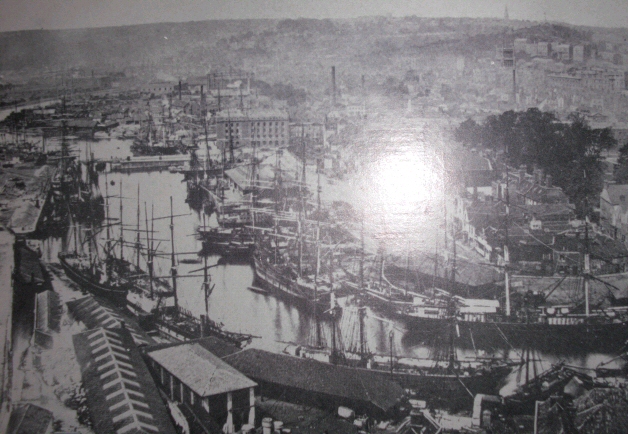
Filton is a northern suburb of Bristol and very rural, farming area. On my first day there, I walked out the hotel looking for a Sainsbury (large grocery store) that the receptionist told me was a 5 minute walk from the hotel (she obviously doesn’t walk much because it was a 20 minute walk at fast pace; maybe a 5 minute drive). I went the wrong way and in 5 minutes was walking down an English country road with farms to the left and right. One of the houses I came to was a business that said on its sign that it specialized in making hanging flower plants. And I wondered what an odd, niche business that was. To spend your whole life making hanging plants. It was a large main house with farm behind it, and at least one truck in the large car port in front of the house with the name of the business on it. Well not so niche after all, as throughout the rest of the trip I noticed how many hanging plants there are, all over Bristol; in every hotel, every restaurant; all over the front of train stations, hotels — everywhere. Britain is a wet, cool, and rainy place, and you’ve got to figure hanging plants help to brighten everything up. And plus there is so much rain you don’t ever have to worry about watering them. It rains seemingly at least three or four or five times every day. Even if it’s a great, clear sky day; at some point some cloud will roll in, and you’ll get at least a sprinkle if not a shower. Massive white billowy clouds, with dark scary centers; fresh off the Atlantic ocean.

So that’s about all I have to say about Bristol, this time around. Loved the place; absolutely loved it. Britain’s First City of Hanging Plants (although Bath might have just as many but I don’t know because I didn’t make it there). Next time over, if I ever go there again, I’ll make sure to check out Kingsdown and Cheltenham Road, and also there’s supposed to be a heck of a suspension bridge on the Western side of town 10 minutes due West of the furthest west I was — past Bristol University and beyond.
More Pictures
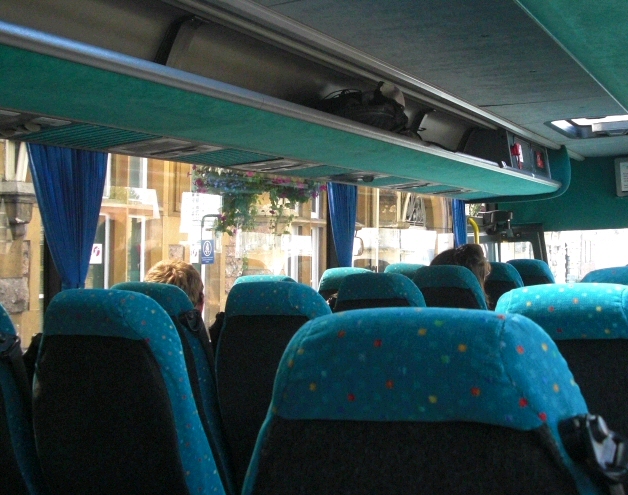

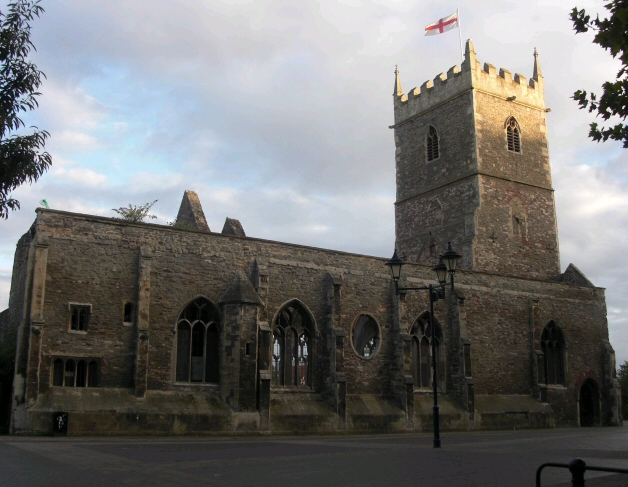
Inside St. Peter’s Church, left as is after Luftwaffe bombings 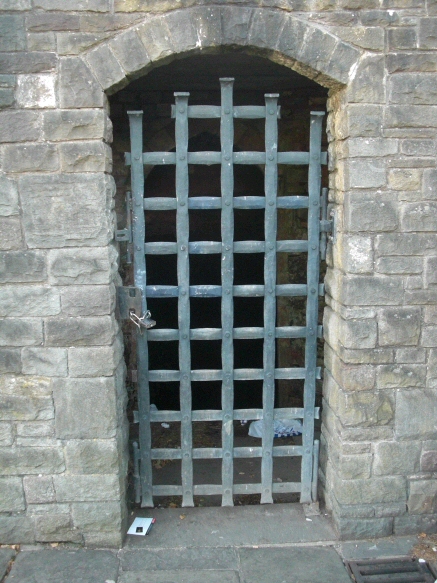
Looking inside Sally Port
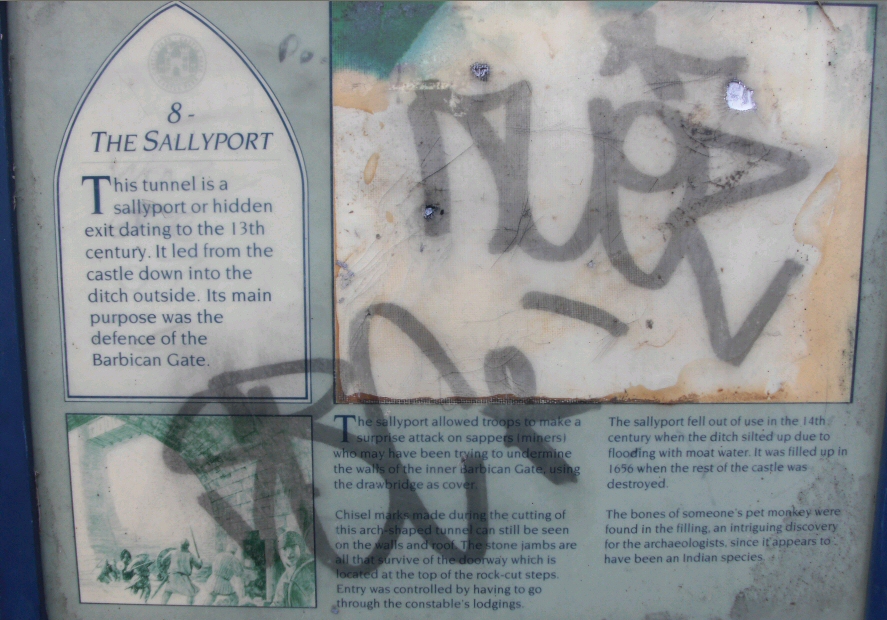
Lou V poses in front of castle walls (partially painted yellow, and then left in original condition to right of that around corner
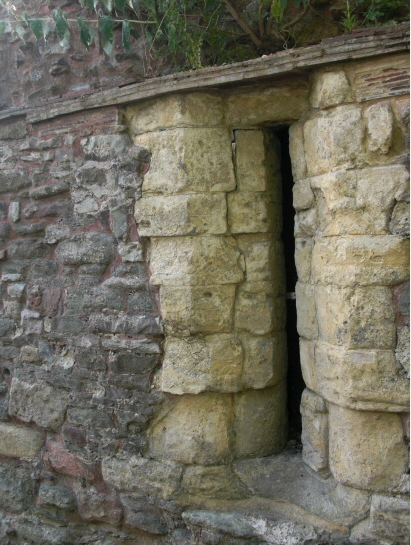
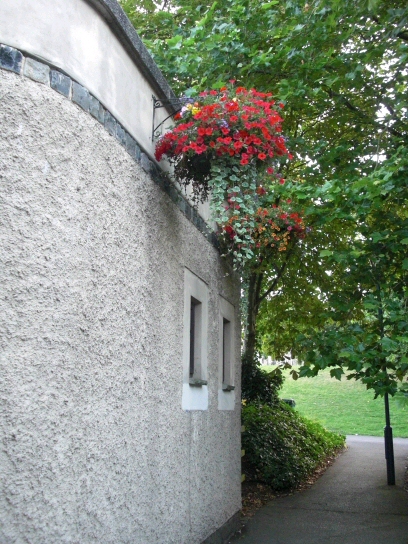
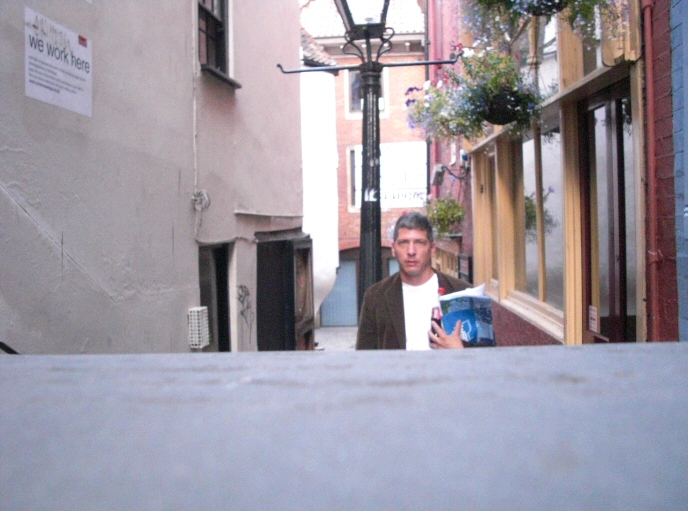
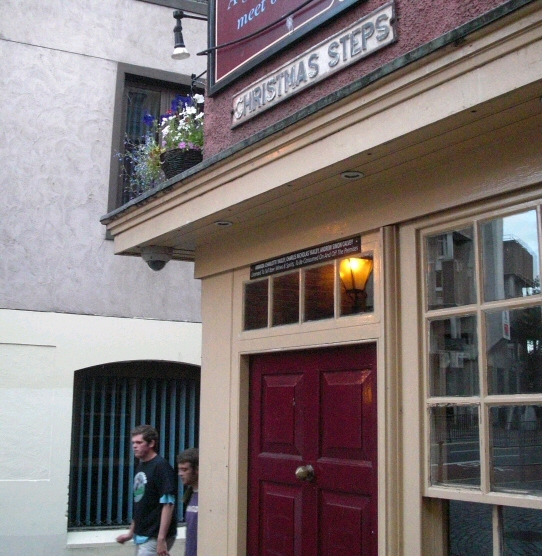
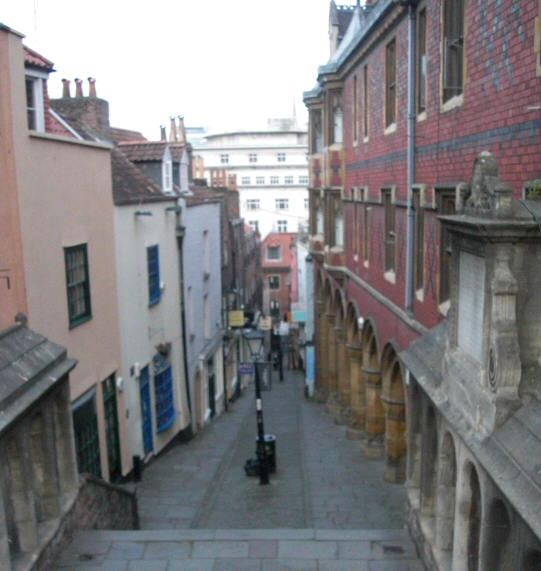
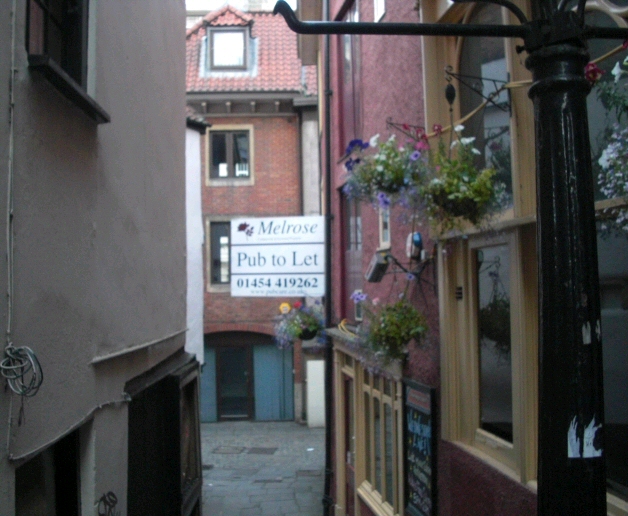
More hanging plants — by eatery adjacent Avon River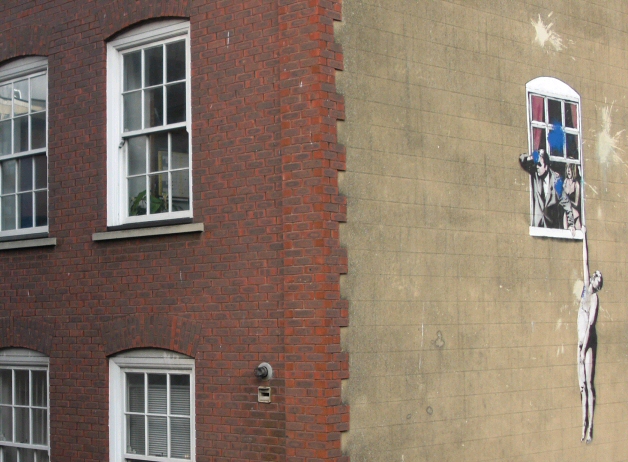
Painting of a ship on the river Avon — perhaps it is the Matthew that John Cabot discovered Newfoundland with? It was in a gallery a block from Castle Park across from the Bristol mall, selling for 850 pounds.

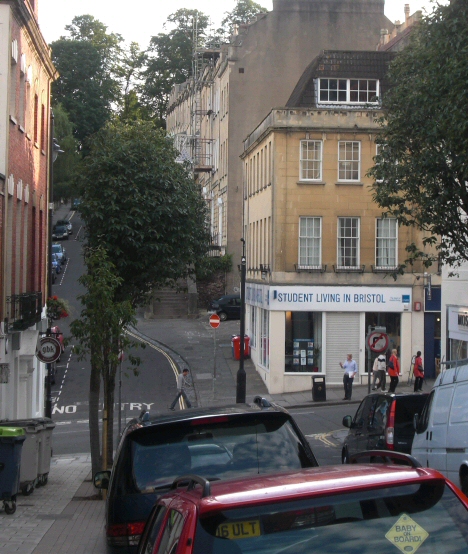
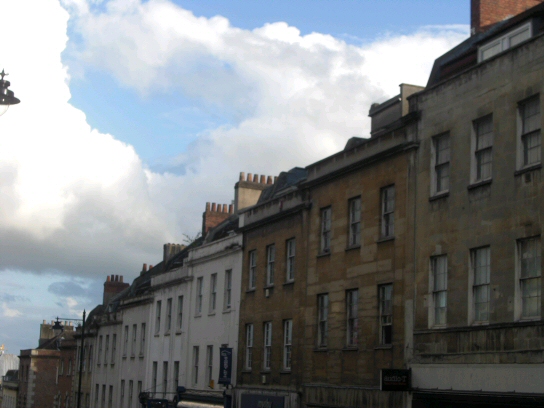
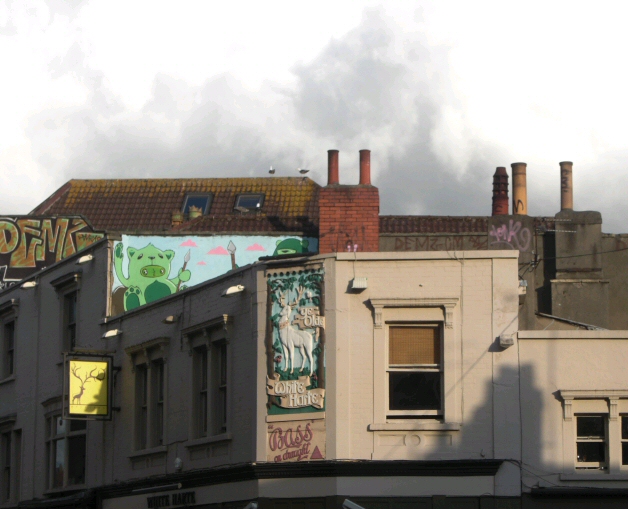

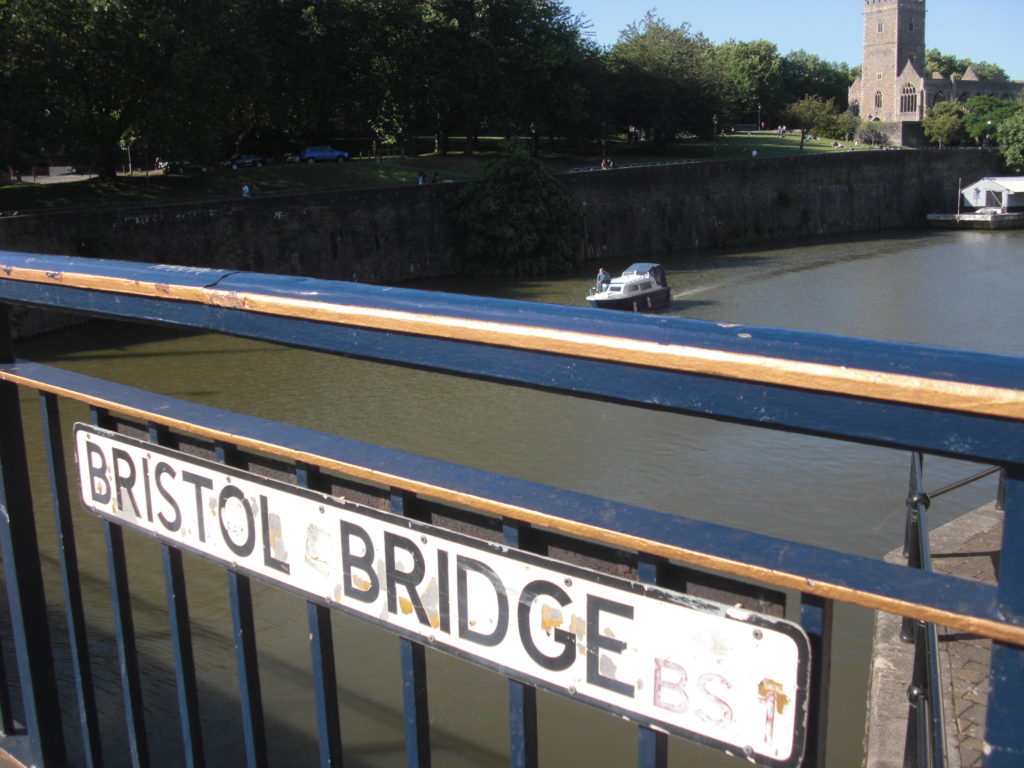
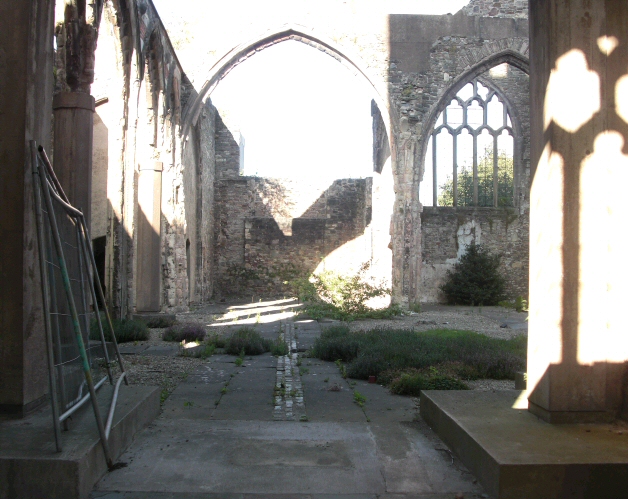

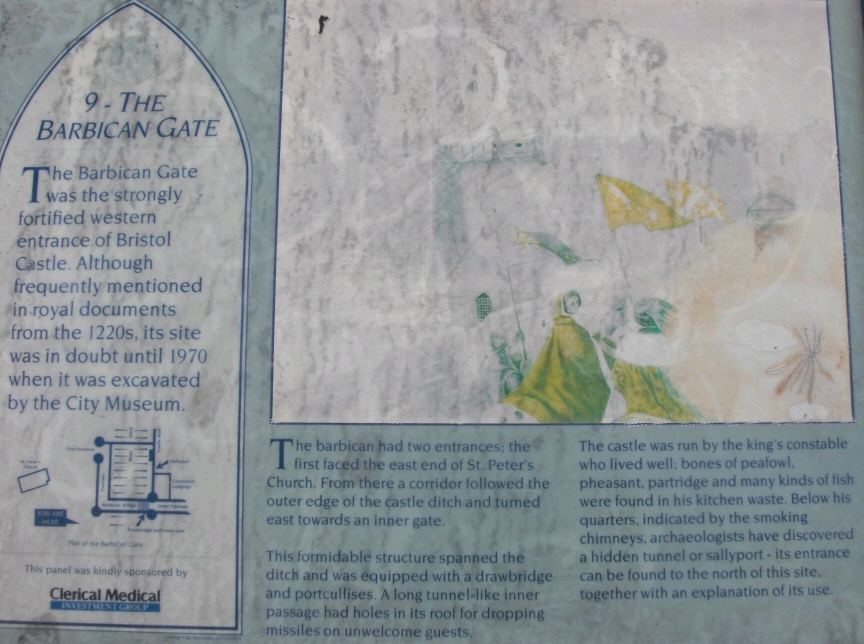
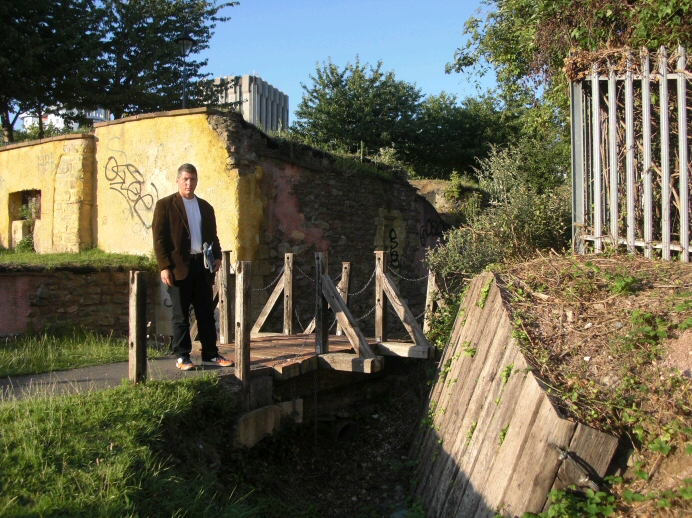
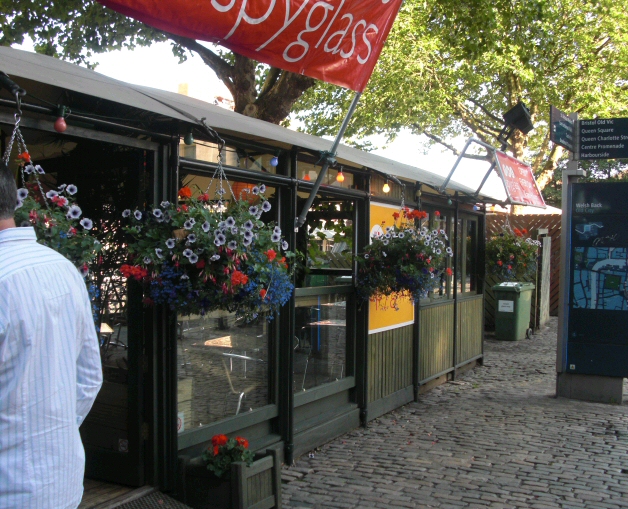
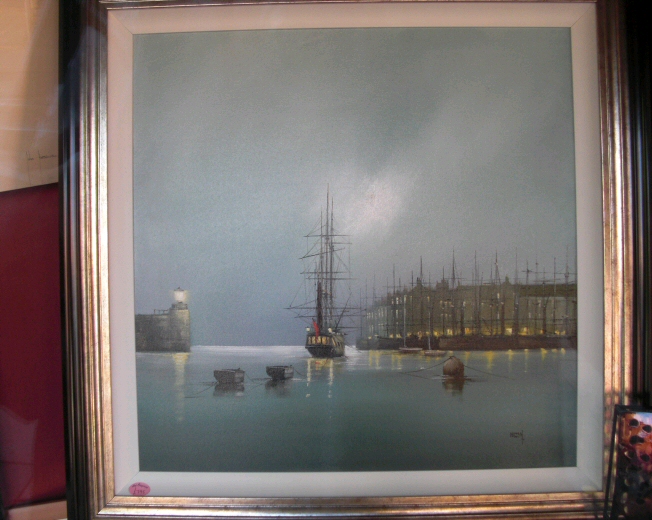
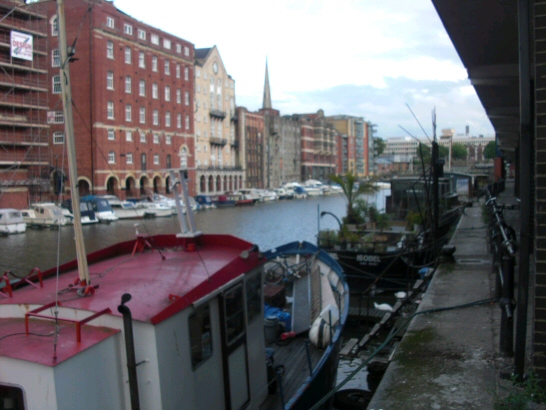
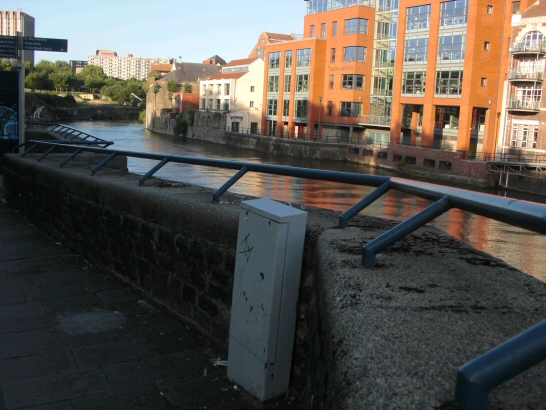
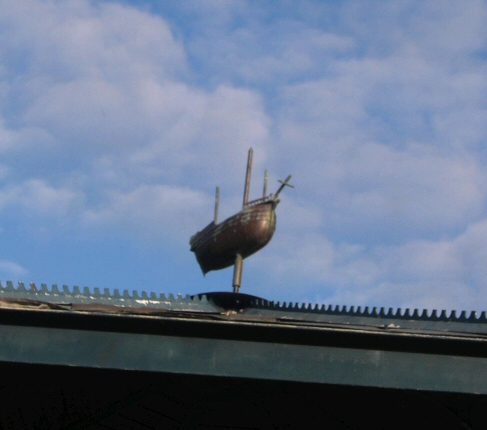

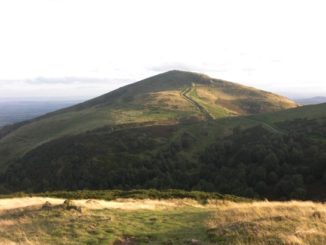
Be the first to comment